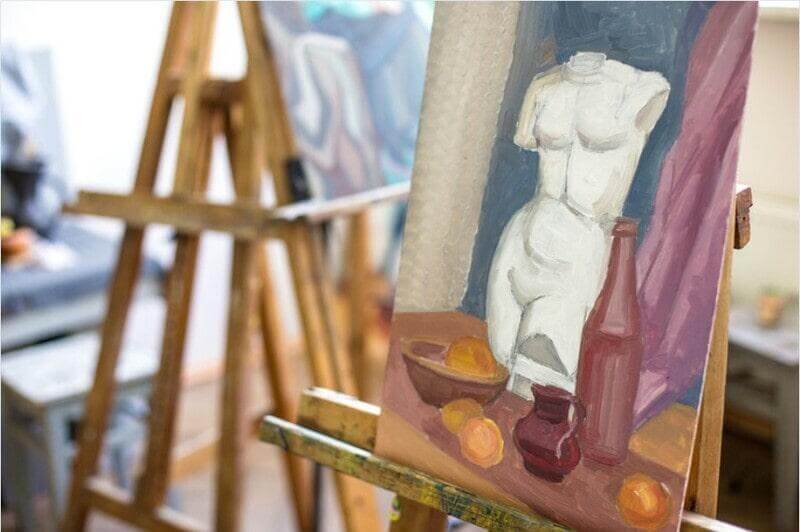Author: Randeep Singh / go to all Samkhya Karikas

Samkhya Karika 41
Smakhya Karika 41 text:
Chitram yathaa ashrayam rte sthaanvaadibhyo vinaa yathaa chaayaa I
Tadvad vinaa visheshaih tishtathi niraashryam lingam II
Chitrum – picture, painting
Yatha – similarly
Ashrayam – support
Rte – uphold, stand
Sthaanvaadibhyo – stake / pole held in position, place
Vinaa – without
Yathaa – as
Chaayaa – shadow
Tatwad – likewise, similarly
Vinaa – without
Visheshaih – subtle substances
Tishtathi – stands, exists
Niraashryam – without support
Lingam – mark that signifies Buddhi
Samkhay Karika 41 discusses the importance of subtle body as a support on which the Buddhi exists.
Samkhya Karika 41, Analogies of an Easle and a Stake / Pole
This Sankhya Karika text uses two analogies in order to make its point clearer.
First it compares the role of the subtle body towards Buddhi to the easel on which the painting frame is supported for it to be displayed. As the Easel is to the picture / painting on display, so is the subtle body to Buddhi.
Thus the subtle body made up of the Tanmatras is crucial to the existence and functioning of the inner sense organs – Buddhi, Ahamkara, and Manas – as they need a kind of framework in which to exist and function as a unit of a particular Subtle body. Both are interdependent on each other for their existence as the inner sense organs help frame the rest of the subtle body around them.
The second analogy given is of the shadow of a stake or pole cannot exist without the pole first being held in position. The pole is the Tanmatras due to which Buddhi, along with other inner sense organs, can exist as its shadow. This Samkhya karika emphasizes upon the significance of a substratum for something to hang on to, stick to for its existence. That substratum is the subtle body made of Tanmatras which help hold buddhi in place.
One of the commentator on Samkhya Karika 41, Vijnana Bhiksu, on this karika calls the subtle substratum as the five Tanmatars where as others have called it the subtle body. Whatever they call it, it is the supporting substratum for the inner sense organs.
The word ‘ visesa’ as mentioned in the karika represents special substances which are too subtle for the 10 external sense organs to know or perceive. These subtle substances, apart from acting as a substratum, also help Buddhi (intelligence) to function or rationalize the information presented to it by all the other 12 sense organs.
The substratum, either it is the subtle body, or the subtle substances as mentioned, support the inner sense faculties, without which they cannot be held in place, together as a unit forming a single subtle body. One can even say that the subtle substances, Tanmatras, or the subtle body act as a cementing material for the three inner sense organs as well as in constructing the entire subtle body.
Significance of Inter-Dependance of Prakriti & Purusha
The function of Purusha is just to witness, see the play or drama presented by Prakriti to it. In order to fulfill its function of being a spectator to the play of Prakriti it needs prakriti or is dependent on Prakriti. One needs to understand that ones the play is over, or Prakriti gets dissolved by the practice of Yoga, the audience leaves and nothing remains behind of the show that was at play by the elements of Prakriti.
Understanding this is the basic understanding of life. The material world or Prakriti is not eternal, it will perish sooner or later. There is no point in just reaming engrossed in it only and not realizing the purpose of life, experiencing the Purusha. Samkhya Philosophy helps one understand life and how to go about it the right way. As by reading the operations manual one can properly operate the machine, so can one lead life the right way if one understands it right.
Buddhi must be used as a driver of the vehicle of life to reach its right destination, or emancipation from the material world. This is known as attaining liberation or Moksha. We normally remain engrossed in the material (Prakriti) world up till the time the sensations emanating from the material objects are pleasurable. The moment one confronts pain and suffering one is forced to turn to philosophy in order to handle it
This is when the real understanding seeps in. The cause of pain is Avidya (wrong knowledge) which is taking unreal (Prakriti) for real. Sankhya Darshan helps clarify the difference and helps us tread the path towards final liberation from the bindings of Prakriti.
